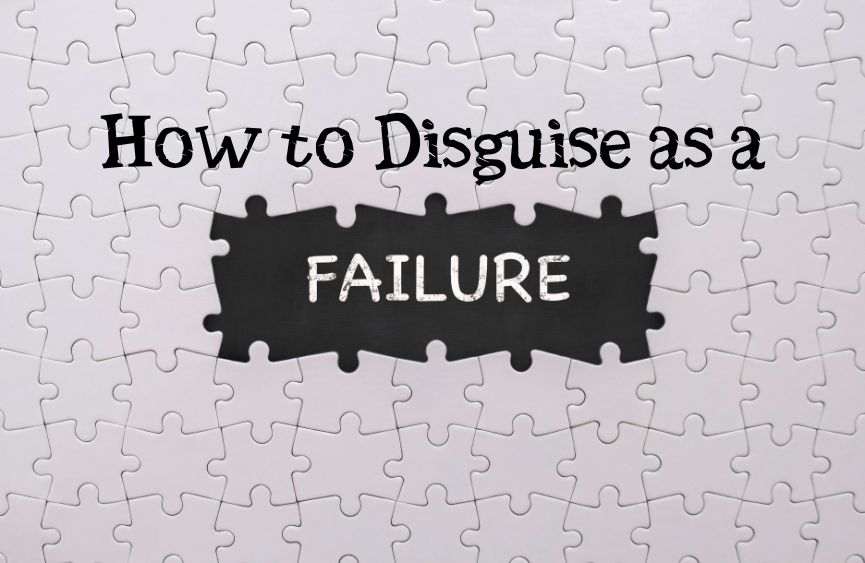How to Disguise as a Failure: Embracing the Unusual
In a world obsessed with success, the idea of disguising as a failure might sound like swimming against the current. Why would anyone want to hide their achievements and successes, you ask? Well, it’s a curious, almost rebellious act, challenging the norms we’ve all grown accustomed to. This journey isn’t just about pretending to fail; it explores its humility, perception, and the sometimes blurred line between success and failure. As we peel back the layers of this unconventional topic, let’s keep an open mind, and maybe we’ll discover something unexpectedly profound.
Understanding Failure: More Than Meets the Eye
The Many Faces of Failure
Often seen as life’s biggest boogeyman, failure is a complex, multifaceted experience. It’s not just about losing or not achieving your goals; it’s about the learning curves that often go unnoticed. In different contexts – personal, professional, or social – failure can wear many hats. It’s a missed deadline, a broken relationship, or a lost opportunity. But, here’s where it gets interesting: failure is not the antithesis of success, but rather its shadow, always present, shaping and defining our successes in ways we often fail to acknowledge.
Busting Myths
We’ve all heard the clichés: “Failure is not an option,” “Winners never quit,” and so on. But these adages oversimplify a much more intricate reality. Failure is not the grim reaper of dreams; it’s more of a tough-love teacher guiding us through life’s most important lessons. By understanding and accepting failure, we open ourselves up to growth, resilience, and grit. It’s time to debunk the myths and recognize that failure, in its own right, is a vital part of the human experience.
Why Play the Failure Card?
Dodging the Spotlight
Imagine you’re at the peak of your game, with success knocking at your door at every turn. Sounds ideal. But sometimes, the glare of the spotlight can be blinding and the weight of expectations crushing. By disguising as a failure, you cleverly sidestep these burdens. It’s not about denying your capabilities but rather about seeking a respite from the constant pressure to outperform, excel, and be the best. In this disguise, you find a peculiar kind of freedom – the freedom to be imperfect and human.
A Lesson in Humility
There’s a subtle art to wearing the mask of failure, especially when you’re accustomed to success. It’s an exercise in humility, a chance to step down from the pedestal and walk among the ‘mortals.’ This act, bizarre as it may seem, is incredibly grounding. It’s a reminder that we’re all fallible, all prone to mistakes, and that’s perfectly okay. In this exploration of humility, you learn about yourself and gain a deeper, more empathetic understanding of those around you. It’s a journey inward as much as it is outward.
A Social Experiment
Now, here’s where it gets really interesting. Disguising as a failure is like conducting your own social experiment. You get to observe firsthand how people react to failure – both yours and their own. It’s a unique vantage point to study societal attitudes towards success and failure. How do people change their behavior around you? What does this say about our collective psyche? In this role, you’re not just a participant in the social fabric but also a keen observer, unraveling the intricate dynamics of human interaction and societal expectations.
Mastering the Art of ‘Failure Disguise’
In Your Personal Life
Here’s where the act gets personal. Think about your circle – friends, family, those who’ve seen your highs and lows. Now imagine toning down your achievements in their eyes. It’s not about being deceitful but creating a space where you’re not always ‘on top.’ This move can be liberating. You’ll find conversations shifting from your successes to more genuine, heartfelt exchanges. It’s about stepping away from the limelight and seeing relationships evolve when the mask of perfection falls off. It’s a humbling experience that redefines connections in the most unexpected ways.
At Work
The workplace can often feel like a battleground for recognition and success. But what if you chose to understate your contributions? Imagine letting others bask in the glory of a well-done job while you quietly revel in your understated role. This approach isn’t about fading into the background but redefining what it means to be a team player. It’s about finding value in leading, supporting, guiding, and sometimes, just being a part of the ensemble. It’s a lesson in humility and teamwork that reshapes professional dynamics and personal growth.
On Social Media
In the era of social media, where life often appears as a highlight reel, consider showcasing the bloopers instead. Share your setbacks, your not-so-perfect moments. It’s a refreshing change from the constant stream of successes and achievements that flood our feeds. This approach humanizes you; it makes you relatable. It’s a gentle reminder to your network that it’s okay to falter, to be less than perfect. This vulnerability, though daunting, can foster a sense of community and support, breaking down the barriers erected by unrealistic expectations of constant success.
The Mind Game: Psychological Implications
This journey of disguising as a failure is more than just an external facade; it’s a profound internal exploration. It challenges you to reevaluate your self-worth, separate from your accomplishments. This mental exercise can be both daunting and enlightening. It forces you to confront your insecurities and fears head-on, often leading to unexpected personal growth. However, it’s crucial to strike a balance. The goal is not to lose yourself in this disguise but to use it as a tool for self-reflection and understanding. It’s about learning to value yourself for your successes and the strength and character you exhibit in the face of adversity.
Real-Life Disguises: Case Studies

Historical Hide-and-Seek
History is replete with tales of people who’ve donned the cloak of failure only to emerge stronger. These stories aren’t just about the falls but about getting back up and resilience. Look at some of these historical figures – how they embraced their failures, learned from them, and used them as stepping stones to greater achievements. Their journeys offer invaluable lessons in the power of persistence, the beauty of resilience, and the essence of real success.
Celebrities: The Comeback Kids
The world of celebrities is another fascinating arena in which to explore this concept. We’ve seen public figures fall from grace only to rise like a phoenix from the ashes. Their comeback stories are a testament to the human spirit’s resilience. They teach us that failure is not a full stop but a comma, a pause that sets the stage for a stronger, more compelling narrative. These stories of redemption and resurgence offer a glimpse into the transformative power of embracing and overcoming failure.
Walking the Tightrope: Balanced Self-Depiction
Treading this path requires a delicate balance. How do you maintain your true self while donning the guise of a failure? The key lies in authenticity. It’s not about self-deprecation or selling yourself short; it’s about presenting a more rounded, holistic view of who you are. This act is about acknowledging your vulnerabilities and imperfections alongside your strengths and achievements. It’s a tightrope walk between humility and self-respect, where you learn the value of each aspect of your personality and life experiences. This balance is crucial for how others perceive you and, more importantly, how you perceive yourself.
Ripples in the Pond: Societal Impact
Disguising oneself as a failure can create ripples that extend far beyond your personal sphere. It challenges and potentially changes the societal narrative around success and failure. By openly embracing your losses, you encourage others to do the same, fostering a more accepting and realistic society. This shift can have profound implications, from reducing the stigma around failure to encouraging more honest and supportive dialogues. Your journey can encourage others to embrace their shortcomings and understand that success is not a one-dimensional concept defined only by victories and achievements.
The Ethical Conundrum
Navigating this path also raises some ethical considerations. How do you balance disguising yourself as a failure without misleading others or diminishing your true accomplishments? Being mindful of the fine line between humility and deceit is essential. The intention should not be to garner sympathy or manipulate perceptions but to explore and understand the multifaceted nature of success and failure. It’s about being responsible in presenting yourself and recognizing the influence and impact your portrayal can have on others, especially those who look up to you.
Conclusion: How to Disguise as a Failure
As we wrap up this intriguing exploration, it’s clear that disguising as a failure is more than just a quirky concept. It’s a profound journey into the heart of what it means to be successful and human. It’s about embracing all facets of life, the ups and downs, the triumphs and setbacks. This journey is a reminder that in the grand tapestry of life, every thread, whether colored by success or failure, adds depth and richness to the picture. So, here’s to failing forward, learning, growing, and, most importantly, understanding the true essence of success.
Further Reading and Resources
Curious to delve deeper? There’s a wealth of resources out there. From insightful books and thought-provoking articles to engaging workshops and courses, exploring the dynamics of success and failure is vast and varied. These resources can offer new perspectives, practical advice, and a deeper understanding of this complex topic. So, go ahead, embark on this journey of discovery, and see where it takes you.
And there we have it – a guide not just to disguise as a failure but to understand and embrace the intricate dance of success and failure in our lives. Remember, it’s not about the fall but about getting back up. Keep exploring, keep questioning, and most importantly, keep growing.
View our previous articles here:







